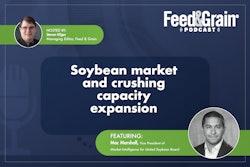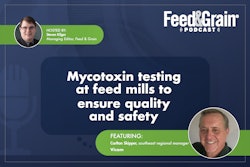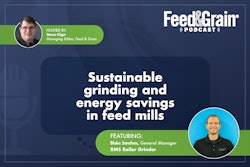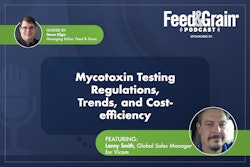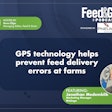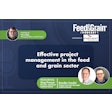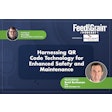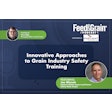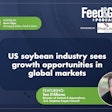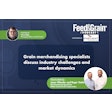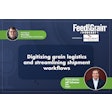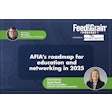
Steven Kilger, the managing editor of Feed & Grain and host of the Feed & Grain Podcast, interviews Mac Marshall, the vice president of market intelligence for the United Soybean Board (USB) and the US Soybean Export Council. During part two of their discussion, the cover the Soybean Checkoff Program and its role in encouraging innovation with soybean products.
Transcript has been edited for clarity.
Steven Kilger: Hi everyone. My name is Steven Kilger. I'm the managing editor of Feed & Grain and the host of the Feed & Grain Podcast. Thank you so much for joining me today as we dive deep into the issues affecting feed manufacturing, grain handling and other allied industries.
Today, I'm speaking with Mac Marshall, vice president of market intelligence for the United Soybean Board (USB) and the US Soybean Export Council. This is part two of the conversation, where we're talking about the Soybean Checkoff Program, how they encourage innovation with soybean products, and some of the fun innovations that might be happening just around the corner. In part one of the conversation, we have a candid conversation about the state of the U.S. soybean market, this year's harvest, and the wave of expansion in crush capacity.
So thank you so much for listening. Before we start, if you're listening to this in a podcasting app, please rate us and subscribe. If you're listening online, sign up for the Feed & Grain newsletter Industry Watch, to see the latest podcasts and stay up to date with all the latest news around the industry. Let's get into it ...
Hi Mac, thanks for coming today. Can you tell us more about the Soy Checkoff Program?
Mac Marshall: Think of the wave of innovations that have unfolded over the last 30 years. I'm going talk about renewable diesel as an emerging space here and new center of demand for soybean oil that's creating all these ripple effects throughout the soybean economy. I don't think we're in that place without checkoff investments toward finding a home for soybean oil in biodiesel. Back in the 1990s, the market environment that we're looking at now stands on the shoulders of giants from then. That's important to remember. Checkoffs are also working on market expansion domestically and internationally, and they think about how export-oriented the soybean industry has become. We export on a volume basis, over half the soy produced in this country, either in the form of meal oil or whole beans.
Maybe some of that shifts in the coming years as we start crushing domestically, but all of the market developments that we're seeing unfold now are outcomes of prolonged investment toward research and development and marketing and promotion, being able to showcase the intrinsic and extrinsic benefits of the U.S. origin soy.
It's advancing our sustainability profile, telling the story about it. All of these things are enabled through investments that the soy checkoff has made. Let's think about even beyond our world of soy here -- projects that we're particularly proud of in the inception. This predates me, so there's nothing I can take credit for, that's for sure.
It's the dredging of the Lower Mississippi River. Several years ago, USB had decided to invest $2 million toward site design feasibility studies. Basically all the preconstruction pre-dredging work for the lower Mississippi River because we can't invest toward physical infrastructure, we can't invest when steel is in the ground, we can't invest for the actual physical dredging. But for the feasibility studies, economic impact, understanding what the benefits and value and realistic ability to have that dredging project executed -- that $2 million investment toward report site design -- everything helps analyze and unlock hundreds of millions of dollars in state and federal funding that says, "Hey, lowering the draft, the lower Mississippi River from 45 to 50 feet, that is going to generate some pretty important economies of scale, as we're able to get larger vessels in into that channel."
That means greater efficiency of transportation, which if you're thinking from the export side, which we're going to orient for soy, again, that means saving on transportation costs. As you get more efficient transportation, your transportation costs go down, your basis goes down. That means farmers are taking less of a haircut on basis. That's phenomenal.
But let's also consider soy's attribution rather than using using this investment as an example. Soybean farmers aren't the only products that use the Mississippi River, right? There's a whole host of other industries that utilize that shipping raw material commodities up and down. You can think about construction materials, cement concrete, all that having greater efficiency there.
This is certainly critical for other parts of the economy. We're thinking about the input side for farmers. Again, we think about vessels going down in the city, vessels also go back up, bring fertilizer and crop protection products, other things that are needed for farming. If you have efficiency on getting those items to farmers, that's also a benefit.
We certainly have seen over the last couple of years the impact that snarled supply chain lines can have on the ability to produce in the manufacturing sector, but certainly in farming as well. I mentioned earlier that last year, not as much corn went in the ground due to some availability issues with fertilizer and other inputs. Anything that can be done to help debottleneck and streamline that is important. Just one check off investment there, and one that I think impacts a lot.
Another we're working on now is investing toward the expansion of the board of Grays Harbor in western Washington State. Why does that matter? Because that's a critical meal export terminal. Seeing the capacity go from 3 million pounds annually to 6 million is pretty substantial when you consider the volume of meal coming online in the coming years. We need to have an efficient means of transportation, to get it from point of crushed to point of use, within the country or flowing out into those export channels through that port.
So, there's a lot of things that come together. It does ripple out to me. A recent study came out showing its contribution economy of over $124 billion annually. That's not an insignificant figure. That's more than half a percentage point of total U.S. economic activity. Nice report.
Seeing all the places that soy touches does emphasize what a strong overall demand environment we have. There's increasing appreciation for all the uses and versatility of soy. Of course, just as our farmers never rest on their laurels and are always exercising continuous improvement, the same is true for the checkoff and how we think about the ways of investments that are going to be generating that next round of value for farmers and our partners throughout the value chain to the consumer.
Kilger: That's a really good point. Especially because when you look outside of it, and you don't know much about the program, people tend to forget that soy farmers are all individual business owners that tend to be pretty small. I know there's a big myth about giant factory farms, but in my experience, large farms aren't all that common.
Marshall: The vast, overwhelming majority, well, over 90% of farms in this country are family.
Kilger: So they're small, and we need someone, a group, to come together to advocate for them, because it's impossible to do it for yourself. You can't be an ambassador to us. You're also on the farm, trying, to grow it. It's a lot to ask.
Marshall: It is. That's one of the things that I find impressive with our farmer directors -- those are volunteers. They're volunteering their time away from the farm to help set up the industry better in the years ahead. We talked about intergenerational farming, and there's a lot of justifiable pride in that. Farmers don't farm for a year. They're the best stewards of the land and want to make sure that the subsequent generations can prosper as well. That's why you have to continually have this ability to tell your story individually and collectively.
To your point, all farmers are business people, and they each have their own unique story. I love hearing those. I love it when people who otherwise wouldn't meet a farmer finally get to hear how their operations work and their story of their farm. It lends another layer of appreciation to the role that food and ag play in each one of our lives. Part of this is to make it more seen and heard.
Kilger: That's a really good point, especially because it always annoys me when farmers are kind of demonized in popular culture, usually by people who have never met a farmer in their lives.
Marshall: Exactly. You and I, we've had the opportunities to meet people in agriculture. Even coming from non-ag backgrounds, it's being able to meet people that help get you more and more interested, better understand where you are, what new questions to ask and continue that journey of exploration.
That's all very well and good and exciting, but you can't expect everybody to do that. It becomes more and more incumbent upon the agriculture and farming community to be telling their stories, to reach out to parts of society that may not understand farming or don't have an appreciation for it, or exploring it without truly understanding what it is. It's very easy to demonize the unseen because it's convenient. I think that's probably a negative universal human truth. But once you have those points of connectivity, once you can see somebody, once you can be on their field or hear them talk about it, it changes your perspective. Those are moments that are critical for for drawing out more partnership, unity and collaboration that we need in the ag value chain, but we also more generally need as people.
Kilger: We're all just trying to get by. The same way no farmer wants to destroy the land or pollute or do any of that. We're all just looking for solutions to make it through these crazy world wars, aren't we?
Marshall: Absolutely. And ideally setting up in the best way possible for subsequent generations.
Kilger: Exactly. I've never met a farmer who doesn't secretly want their farm to be passed on to their children or their grandchildren.
Marshall: Absolutely. I've talked with several farmers recently who expressed a lot of concern about that continual creep-up in the average age of farmers in the United States. It's not just the U.S. -- it's being observed on a global basis as well. It raises the question -- if the average age of farmers keeps creeping up, who's going to be the next generation to continue that on? We have to bring more and more young people into that world food and ag. That doesn't necessarily mean farming, but I think it means playing a role in it and helping illuminate just how this all comes together.
Kilger: Exactly. So let's talk a little bit about some of the projects and initiatives you guys have over the United Soybean Board.
Marshall: I think to maybe break it down, I'll give you an idea about how we think about value creation and how that's all setup. We think about deriving value for farmers really through reputation, differentiation and resilience. How do you build more resilient revenue systems and or streams? How do you help differentiate through evidence-based marketing the value of U.S. soy in various applications? And how do you tell about it? How do you answer that reputation piece? The portfolio that farmers are, that our directors will evaluate each year is, you know, subdivided into a couple of different areas. We look at supply and demand across three priority areas. One is infrastructure and connectivity. I mentioned some of the dredging projects in the expansion of the port of Grays Harbor.
Connectivity also means connectivity to markets. That's investing toward rural broadband which is essential for farmers to be able to communicate and have information flow back and forth. It's also continuous market research, better understanding opportunities that are out there, in more novel spaces. Health and nutrition is the second pillar, and that extends everywhere from on a farm in soil health to human health, really the end of the consumer value chain.
It's everything from taking things that are out there, like soy allergenicity and misconceptions around soy. How do we use scientific evidence in research to help demystify that and be like, "Okay, well, actually, the incidence of allergenicity is way less than it's purported to be."
Through that, you can help unlock barriers for additional inclusion in other applications or increased uptake in the food space. With innovation and technology, on the supply side, what are some of the novel things that we can introduce and test on the farm that might lead to increased efficiency of production? I've worked in soy before. When I worked for Monsanto, and Bayer, soy was our second most important portfolio crop on a revenue basis after corn. Corn got the vast majority of my attention. I was always thinking in a very commoditized space. Think about soy as something for animal feed or to a lesser extent, for biofuels. Those are really two of the bigger buckets that are out there -- and of course, food applications.
But, there all the unique places that you can find such as surfactants, adhesives, concrete stabilizers, tires, dust suppressants, in fire extinguishers, It's crazy how many places you can find them. That's all stuff that goes on through that innovation technology funding stream. It's working with universities and private sector players who are trying to advance proofs-of-concept, seeing the viability of selenium in various applications. Sometimes these things take a while to catalyze commercialize, you know, scale up all the places you can have. It helps harness the power of the whole bean.
Kilger: So innovation challenge for 2023 is coming up soon. Can you tell us anything about it yet?
Marshall: This one is very fun. This is the third iteration. The first one we conducted in 2020, in conjunction with the Yield Lab Institute, as their operational partner, and Amazon Web Services. That challenge was open-ended and focused on what innovations people who are working discovery around the world, what can they bring to different parts of the value chain? Our winner then was company called FluroSat, which is now is Regrow Ag. They taken off over the last couple of years, so that's exciting. We had a challenge earlier this year focused on soy meal. Now, the reason we focus on soy meal as well is that increased crush capacity we have coming online and increased availability of meals. The time is right for finding ways to advance soybean meal utilization in existing channels.
The winner, Satavie has a novel extraction process for soymeal that can lead to advanced health outcomes for animals that are consuming meal in that process. So that's exciting.
This third challenge is very meal-focused as well, but it's on novel applications that we might not have seen before. Now, oil gets a lot of use in the industrial space; meal, less so. As far as industry leaders out there, we're excited to have this somewhat open aperture to parts of the economy and people in the technology and R&D space in industries that maybe we haven't been as close with or haven't touched before. But, you know, if there's an application for soymeal, ability to use it, and someplace that we haven't considered before, this is the opportunity for creative and smart, business-savvy innovators to come together and start showcasing what can potentially be done there. We're partnering again with Yield Lab Institute. I'm excited to see the wave of applications come in and to see what all the ideas are for soymeal.
Kilger: Excellent. Thank you so much for speaking with me today. It was a real pleasure and very informative. I hope you come on again soon.
Marshall: I hope so too. Steven, this is an absolute delight. I love being able to come on and talk about the versatility of soy markets and things that checkoff is doing. I do get very, very excited about food and agriculture and the promise and the opportunities that are out there. Being able to share a little bit about that means a lot. Thank you so much for having me on.
Kilger: You've been an amazing guest. Thank you so much. And thank everyone out there for listening. We'll be back soon.
For part one of Steven and Mac's discussion, click here.
.jpg?auto=format%2Ccompress&crop=faces&fit=crop&h=48&q=70&w=48)


